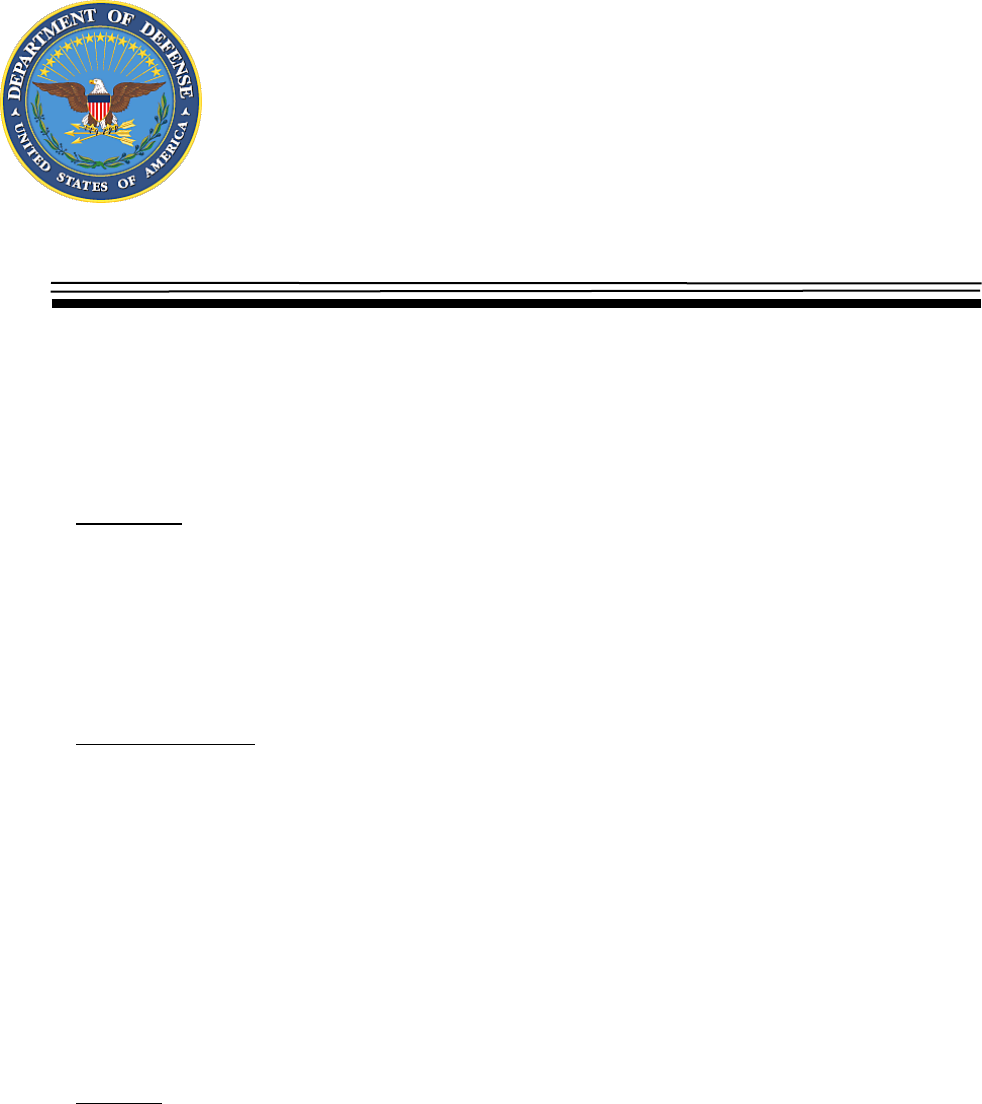
Department of Defense
INSTRUCTION
NUMBER 5015.02
February 24, 2015
Incorporating Change 1, August 17, 2017
DoD CIO
SUBJECT: DoD Records Management Program
References: See Enclosure 1
1. PURPOSE. This instruction reissues DoD Directive (DoDD) 5015.2 (Reference (a)) as a
DoD instruction (DoDI) in accordance with the authority in DoDD 5144.02 (Reference (b)) to
establish policy and assign responsibilities for the management of DoD records in all media,
including electronic, in accordance with subchapter B, chapter XII, of Title 36, Code of Federal
Regulations (CFR) and chapters 29, 31, 33, and 35 of Title 44, United States Code (References
(c) and (d)).
2. APPLICABILITY. This instruction applies to:
a. OSD, the Military Departments, the Office of the Chairman of the Joint Chiefs of Staff
(OCJCS) and the Joint Staff, the Combatant Commands (CCMDs), the Office of the Inspector
General of the Department of Defense, the Defense Agencies, the DoD Field Activities, and all
other organizational entities within the DoD (referred to collectively in this instruction as the
“DoD Components”).
b. DoD information created, received, collected, processed, maintained, disseminated,
disclosed, or disposed of by or for the DoD, in any medium or form, including information
managed by DoD or a third party on behalf of DoD.
3. POLICY. It is DoD policy that:
a. The information and intellectual capital contained in DoD records will be managed as
national assets. Effective and efficient management of records provides the information
foundation for decision making at all levels, mission planning and operations, personnel and
veteran services, legal inquiries, business continuity, and preservation of U.S. history.
b. Records, regardless of media or security classification, will be created, maintained and
used, disposed, and preserved to document the transaction of business and mission in wartime
DoDI 5015.02, February 24, 2015
Change 1, 08/17/2017
2
and peacetime. Records are evidence of DoD Component organization, functions, policies,
procedures, decisions, and activities pursuant to References (c) and (d), and will be maintained in
accordance with guidance issued by National Archives and Records Administration (NARA),
Office of Management and Budget (OMB) M-12-18 (Reference (e)), and OMB Circular A-130
(Reference (f)).
c. DoD records must be managed in compliance with this instruction and References (c) and
(d) while protecting the legal and financial rights and interests of the Federal Government and of
persons affected by U.S. Government (USG) activities.
d. Essential records (formerly vital records) will be identified, protected, and managed to
ensure availability after an event that disrupts normal operations to support continuity of
operations and to protect rights and interests in accordance with Reference (c).
e. All DoD records will be covered by a records schedule. Approval of the schedules must
be obtained from NARA in accordance with Reference (c).
f. All permanent electronic records will be managed electronically for eventual transfer and
accessioning to NARA in an electronic format.
g. Sound records management principles must be incorporated into DoD business processes
in accordance with the Department of Defense Chief Information Officer (DoD CIO)
Memorandum (Reference (g)), the NARA Federal Enterprise Architecture Records Management
Profile (Reference (h)), and statutory requirements.
(1) Records management requirements (as described in DoD 5015.02-STD (Reference
(i))), issues, and solutions must be identified and linked to their implementing technologies and
business processes.
(2) Records management requirements will be integrated into DoD Component
information technology (IT) governance processes for portfolio management, risk management,
capital planning, enterprise architecture, business process design, and system development.
h. The acquisition, development, and enhancement of electronic information systems (EIS)
and IT services must incorporate records management and preservation considerations, and any
records contained in the systems or IT services must be managed in accordance with NARA-
approved records disposition schedules.
(1) For new EIS and IT services, records will be managed electronically by
recordkeeping functionality provided by the EIS or IT service, or by transferring records to an
electronic recordkeeping repository, such as a records management solution that is compliant
with Reference (i).
(2) For existing EIS and IT services, records will be managed electronically, manually,
or a combination of both. To manage records electronically, recordkeeping functionality will be

DoDI 5015.02, February 24, 2015
Change 1, 08/17/2017
3
provided by the EIS or IT service, or records will be transferred to an electronic recordkeeping
repository, such as a records management solution that is compliant with Reference (i).
i. Records created, sent, or received using electronic messaging accounts must be managed
electronically, including the capability to identify, retrieve, and retain records for as long as they
are needed, in accordance with part 1236.22 of Reference (c) and in accordance with Reference
(i), NARA Bulletin 2012-02 (Reference (j)), or NARA Bulletin 2013-02 (Reference (k)), as
applicable.
j. Unstructured electronic records, other than electronic messages, must be managed in a
records management solution that is compliant with Reference (i) or Reference (j), as applicable.
This includes records created using any electronic applications.
k. Electronic records, EIS, and IT services must be interoperable at the DoD Component and
interagency levels where data is shared or transferred to another federal agency, such as the
Department of Veterans Affairs or NARA. Metadata, standards, and/or mediation will be used
in accordance with DoDI 8320.02 (Reference (l)).
l. Records and non-record materials are government-owned and cannot be copied or
removed from government custody or destroyed, except as authorized in accordance with
References (c) and (d) and DoD Component guidance. This applies to electronic messages used
to conduct DoD business because electronic messages include record and/or non-record material
and cannot be copied, transferred, or removed as personal files. Non-record materials will be
destroyed when no longer needed for business, at the discretion of the DoD Component.
m. DoD personnel will receive records management training annually in order to understand
their responsibilities in managing DoD information as records and how to carry out these
responsibilities.
n. Non-official electronic messaging accounts, with very few exceptions, must not be used to
conduct official DoD communications in accordance with DoDI 8550.01 (Reference (m)). If a
DoD employee uses a non-official electronic messaging account, the employee must copy the
message to his or her official electronic messaging account when the record is first transmitted,
or must forward a complete copy of the record to their official electronic messaging account
within 20 days of the record’s original creation or transmission pursuant to Reference (d).
4. RESPONSIBILITIES. See Enclosure 2.
5. RELEASABILITY. Cleared for public release. This instruction is available on the
Directive Division Website at http://www.esd.whs.mil/DD/.
6. SUMMARY OF CHANGE 1. The changes to this issuance account for changes in statute and
evolving technology. They also update references and acronyms.

DoDI 5015.02, February 24, 2015
Change 1, 08/17/2017
4
7. EFFECTIVE DATE. This instruction is effective February 24, 2015.
Acting DoD Chief Information Officer
Enclosures
1. References
2. Responsibilities
Glossary

DoDI 5015.02, February 24, 2015
Change 1, 08/17/2017 ENCLOSURE 1
5
ENCLOSURE 1
REFERENCES
(a) DoD Directive 5015.2, “DoD Records Management Program,” March 6, 2000 (hereby
cancelled)
(b) DoD Directive 5144.02, “DoD Chief Information Officer (DoD CIO),”
November 21, 2014, as amended
(c) Subchapter B, chapter XII of Title 36, Code of Federal Regulations
(d) Title 44, United States Code
(e) Office of Management and Budget and National Archives and Records Administration M-
12-18, “Managing Government Records Directive,” August 24, 2012
(f) Office of Management and Budget Circular A-130, “Managing Information as a Strategic
Resource,” July 28, 2016
(g) Department of Defense Chief Information Officer Memorandum, “Defense Information
Enterprise Architecture, Version 2.0,” August 10, 2012
(h) National Archives and Records Administration, “Federal Enterprise Architecture Records
Management Profile, Version 1.0,” December 15, 2005
(i) DoD 5015.02-STD, “Electronic Records Management Software Applications Design
Criteria Standard,” April 25, 2007
(j) National Archives and Records Administration Bulletin 2012-02, “Guidance on Managing
Content on Shared Drives,” December 6, 2011
(k) National Archives and Records Administration Bulletin 2013-02, “Guidance on a New
Approach to Managing Email Records,” August 31, 2013
(l) DoD Instruction 8320.02, “Sharing Data, Information, and Information Technology (IT)
Services in the Department of Defense,” August 5, 2013
(m) DoD Instruction 8550.01, “DoD Internet Services and Internet-Based Capabilities,”
September 11, 2012
(n) National Archives and Records Administration Bulletin 2017-01, “Agency Records
Management Training Requirements,” November 29, 2016
(o) DoD Directive 5100.03, “Support of the Headquarters of Combatant and Subordinate
Unified Commands,” February 9, 2011, as amended
(p) DoD Instruction 5010.40, “Managers’ Internal Control Program Procedures,” May 30, 2013
(q) DoD Directive 5101.1, “DoD Executive Agent,” September 3, 2002, as amended
(r) DoD Instruction 3020.42, “Defense Continuity Plan Development,” April 27, 2011
(s) Federal Continuity Directive 1, “Federal Executive Branch National Continuity Program
and Requirements,” October 2012
(t) DoD Instruction 8115.02, “Information Technology Portfolio Management
Implementation,” October 30, 2006
(u) Title 41, Code of Federal Regulations
(v) DoD Directive 5400.11, “DoD Privacy Program,” October 29, 2014
(w) DoD Instruction 6025.18, “Privacy of Individually Identifiable Health Information in DoD
Health Care Programs,” December 2, 2009
(x) Title 10, United States Code

DoDI 5015.02, February 24, 2015
Change 1, 08/17/2017 ENCLOSURE 2
6
ENCLOSURE 2
RESPONSIBILITIES
1. DoD CIO. The DoD CIO:
a. Develops and establishes DoD policy and standards to implement a DoD Records
Management Program, including the life-cycle management of records in all media in
accordance with References (b), (c), and (d).
b. Oversees DoD records management.
c. Serves as the DoD Senior Agency Official for Records Management (SAORM) pursuant
to Reference (e), ensuring compliance with References (c) and (d). Determines which DoD
Components are required to designate Component SAORMs. Collaborates with the Component
SAORMs to fulfill the duties pursuant to Reference (e).
d. Appoints the DoD Records Officer to guide and coordinate the DoD Records
Management Program. The DoD Records Officer collaborates with DoD Components and
NARA to execute the DoD Records Management Program in accordance with this instruction
and the responsibilities contained in section 1220.34 of Reference (c) and References (b) and (d).
e. Provides records management training, as required, to educate DoD personnel of their
records management responsibilities, in accordance with NARA Bulletin 2017-01 (Reference
(n)) and pursuant to Reference (e). Maintains this DoD-wide training to ensure its relevancy and
timeliness, and provides the training to DoD Components for execution.
f. Identifies DoD Components that are required to have their designated records officer hold
the NARA certificate of Federal Records Management training pursuant to Reference (e).
g. Cultivates a DoD records management community of interest by encouraging use of
collaborative tools and technologies to distribute and evaluate the best practices and lessons
learned in records and information management.
2. DIRECTOR, DEFENSE INFORMATION SYSTEMS AGENCY (DISA). Under the
authority, direction, and control of the DoD CIO, and in addition to the responsibilities in section
3 of this enclosure, the Director, DISA:
a. Establishes and maintains a test and evaluation program for certifying automated records
management solutions that meet the standard functional and automated system requirements for
records management in accordance with Reference (i).
b. Recommends to the DoD CIO any revisions to records management functional baseline
requirements to be incorporated into Reference (i).

DoDI 5015.02, February 24, 2015
Change 1, 08/17/2017 ENCLOSURE 2
7
c. Establishes and maintains a register of automated records management solutions and
active DoD recordkeeping systems that meet the standard functional and automated system
requirements in Reference (i). Ready access to this register must be provided to all DoD records
management personnel and be available at http://jitc.fhu.disa.mil/projects/rma/reg.aspx.
d. Develops and provides records management subject matter expertise for planning and
executing the implementation and integration of electronic records management.
3. DoD COMPONENT HEADS. The DoD Component heads:
a. Establish, sufficiently resource, and maintain a DoD Component records management
program at an organizational level of sufficient authority to ensure this instruction and
References (c) and (d) are efficiently and effectively implemented. Designate a records officer
to administer the Component program and provide written notification of designation to the DoD
SAORM. As directed by the DoD CIO, ensure the designated records officer holds the NARA
Certificate of Federal Records Management Training within 1 year of designation pursuant to
Reference (e).
b. Appoint a Component SAORM, as directed by the DoD CIO. Component SAORM will
collaborate with the DoD SAORM to fulfill the SAORM responsibilities pursuant to Reference
(e).
c. Use the most economical, efficient, and reliable means to create, maintain and use,
dispose, and preserve Component records in any media in accordance with References (c), (d),
and (f), and DoDD 5100.03 (Reference (o)).
d. Implement records management controls and accountability standards necessary to
capture, manage, and preserve Component records, including electronic records and electronic
messages and their attachments, using internal controls in accordance with DoDI 5010.40
(Reference (p)).
e. For operational records, support the Combatant Commanders’ (CCDRs) operational plans
for managing records throughout their life cycle. Records generated as a result of campaigns and
contingency operations in the CCMD area(s) of operation (AO) are operational records and must
be managed pursuant to this instruction. Administrative records are the responsibility of the
DoD Component head.
f. For any DoD Executive Agent designations in accordance with DoDD 5101.1 (Reference
(q)), require any records that document the transaction of business and mission of the DoD
Executive Agent are managed according to current records management policy. Assign records
management responsibilities to Components consistent with the DoD Executive Agent
designation and determine the processes that will be used.
DoDI 5015.02, February 24, 2015
Change 1, 08/17/2017 ENCLOSURE 2
8
g. Establish an essential records program to identify and preserve essential records (formerly
vital records). The essential records program will ensure essential records are maintained,
revised and, where appropriate, available after an event that disrupts normal in accordance with
Reference (c) and DoDI 3020.42 (Reference (r)) and consistent with Federal Continuity Directive
1 (Reference (s)).
h. For any EIS or IT service developed, acquired, or provided by the Component, require
that records contained in the EIS or IT service are managed and scheduled in accordance with
Reference (c). Register the EIS or IT service in the DoD IT Portfolio Repository (DITPR) in
accordance with DoDI 8115.02 (Reference (t)). For those EISs and IT services that contain
records, populate and maintain the associated DIPTR records management data elements.
i. Deploy and use a records management solution that is compliant with References (i), (j),
and/or (k) to manage unstructured electronic records pursuant to this instruction and Reference
(e) no later than 5 years after the change date of this publication.
j. Ensure all personnel complete annual records training. This includes incorporating
necessary requirements into contracts to ensure records training is accomplished for contractors
who create, receive, use, or maintain records. The training will educate DoD personnel and
contractors on their records management responsibilities as appropriate.
k. Provide records management training for the staff responsible for the Component’s
records management program and operations.
l. Advise senior leaders of their record management responsibilities within the first 30 days
of assumption of duties. Provide out-briefings to senior leaders to ensure capture of the records
generated during their tenure.
m. Direct contractors performing DoD program functions to create and maintain records to
document these functions. Contracts must specify the delivery to the USG of all the data
required for adequate documentation of the contractor-operated program in accordance with
parts 102 through 193 of Title 41, CFR (Reference (u)).
n. Oversee prompt retirement or disposal of temporary records and the timely transfer of
permanent records to NARA for preservation under NARA-approved record schedules. Transfer
permanent records to NARA in digital or electronic form to the greatest extent possible.
o. Notify the Archivist of the United States of any actual, impending, or threatened unlawful
removal, defacing, alteration, corruption, deletion, erasure, or other destruction of records in the
custody of the Component pursuant to Reference (d). With the assistance of the Archivist,
initiate action through the United States Attorney General for the recovery of records. Inform
the DoD SAORM when the notification concerns permanent or long-term records, impacts more
than one Component, or attracts interest or scrutiny from other agencies, Congress, or the public.
p. Monitor Component compliance with the DoD Records Management Program and
Reference (c), and implement corrective actions when necessary.

DoDI 5015.02, February 24, 2015
Change 1, 08/17/2017 ENCLOSURE 2
9
q. Advise the DoD SAORM of records management issues that could have broad
implications across DoD or between DoD and other government agencies, and fully cooperate
with the DoD CIO in resolving these issues.
r. Work with the DoD SAORM to coordinate responses to existing, new, or changing
records management requirements in accordance with Reference (e).
s. Safeguard all personal data within records, in accordance with DoDD 5400.11 (Reference
(v)). Protect all personal data within health-related records in accordance with DoDI 6025.18
(Reference (w)).
t. Require requests for removal of non-record materials outside of DoD be reviewed by
proper DoD authority, as designated by the DoD Component head. Unclassified documents,
including e-mail, are not automatically publicly releasable and must be reviewed for release to
departing officials or employees.
u. Maintain accountability of records when they are loaned and transferred to other DoD
Components or federal agencies, and accept possession and management responsibility when the
loaned records are returned to the Component. Continue life-cycle management of the records in
accordance with NARA-approved records disposition schedules.
4. CHAIRMAN OF THE JOINT CHIEFS OF STAFF (CJCS). In addition to the
responsibilities in section 3 of this enclosure, the CJCS:
a. Develops, implements, evaluates, and refines records management policies and
procedures for programs and organizations for which the OCJCS has oversight, including joint
operation planning.
b. Requires each CCDR to develop and implement plans and procedures so that all
information and records created or received by the CCMD are identified, safeguarded, and
properly managed.
c. Oversees and assesses records management programs for which the OCJCS has oversight
by reviewing the efficient life-cycle management of records and the scheduling of records in
accordance with References (c) and (d). Monitors the compliance of the CCDR and other
supervised activities with this instruction, directs corrective action be implemented as necessary,
and notifies the DoD CIO of any issues and recommended resolutions.
5. CCDRs. In addition to the responsibilities in section 3 of this enclosure, the CCDRs:
a. Are responsible for operational records to ensure proper management of these records
throughout their life cycle. CCDRs may task any subordinate unit or command, including
Service component commands and theater special operations commands, to fulfill this
DoDI 5015.02, February 24, 2015
Change 1, 08/17/2017 ENCLOSURE 2
10
responsibility in accordance with the CCMD established priorities, operational guidance, and
CCDR intent.
b. Assign and document accountability for the management and ownership of operational
records during deliberate and crisis action planning and throughout the operation.

DoDI 5015.02, February 24, 2015
Change 1, 08/17/2017 GLOSSARY
11
GLOSSARY
PART I. ABBREVIATIONS AND ACRONYMS
AO area of operation
CCDR Combatant Commander
CCMD Combatant Command
CFR Code of Federal Regulations
CJCS Chairman of the Joint Chiefs of Staff
DISA Defense Information Systems Agency
DITPR DoD Information Technology Portfolio Repository
DoD CIO DoD Chief Information Officer
DoDD DoD directive
DoDI DoD instruction
EIS electronic information system
IT information technology
OCJCS Office of the Chairman of the Joint Chiefs of Staff
OMB Office of Management and Budget
NARA National Archives and Records Administration
SAORM Senior Agency Official for Records Management
USG U.S. Government
PART II. DEFINITIONS
These terms and their definitions are for the purpose of this instruction.
administrative records. Those records created by all DoD organizations, regardless of
organizational level, in performing common functions that support the organization’s mission
activities, but do not directly document the performance of mission functions. Administrative
records relate to activities such as budget and finance, human resources, medical, equipment and
supplies, facilities, public and congressional relations, contracting, and similar administrative
housekeeping or facilitative functions common to most agencies.
campaign. A series of related major operations aimed at achieving strategic and operational
objectives within a given time and space.

DoDI 5015.02, February 24, 2015
Change 1, 08/17/2017 GLOSSARY
12
contingency operation. A military operation that is either designated by the Secretary of Defense
as a contingency operation or becomes a contingency operation as a matter of law pursuant to
chapter 1 of Title 10, United States Code (Reference (x)).
contractor. Any person who enters into a contract with the USG for the production of material or
for the performance of services for national defense.
DoD personnel. Military and civilian employees of the DoD.
EIS. An information system that contains and provides access to electronic federal records,
electronic messages, and other information.
electronic messages. E-mail and other types of electronic messages that people use to
communicate. This includes, but is not limited to, messages created by chat, text, and e-mail
systems.
electronic messaging account. Any account that sends or receives electronic messages.
electronic records. Any information that is recorded in a form that only a computer can process
and that satisfies the definition of a federal record pursuant to chapter 31 of Reference (d), also
known as the “Federal Records Act.” The term includes both record content and associated
metadata that the agency determines is required to meet agency business needs.
essential records (formerly vital records). Records an agency needs to meet operational
responsibilities during national security emergencies or other emergency conditions (emergency
operating records) or to protect the legal and financial rights of the USG and those affected by
USG activities.
essential records program. The policies, plans, and procedures the agency develops and
implements – and the resources needed – to identify, use, and protect essential records. This is a
program element of an agency’s emergency management function.
IT service. Engagement of the time and effort of a service provider, through the use of IT,
whose primary purpose is to perform an identifiable task, or tasks, rather than provide an end
item of supply.
intellectual capital. Intellectual capital is the value associated with the knowledge, applied
experience, organizational technology, synergistic interface (corporate-private-public
collaboration), and professional skills that provide an organization with relevance within the
DoD.
interoperable. The condition achieved among communications-electronics systems or items of
communications-electronics equipment when information or services can be exchanged directly
and satisfactorily between them and their users.

DoDI 5015.02, February 24, 2015
Change 1, 08/17/2017 GLOSSARY
13
metadata. Information describing the characteristics of data; data or information about data; or
descriptive information about an entity’s data, data activities, systems, and holdings. For
example, discovery metadata is a type of metadata that allows data assets to be found using
enterprise search capabilities.
non-record materials. Federally owned informational materials that do not meet the statutory
definition of records in accordance with section 3301 of Reference (d), or that have been
excluded from coverage by the definition. Excluded materials are extra copies of documents
kept only for reference, stocks of publications and processed documents, and library or museum
materials intended solely for reference or exhibit.
operation. A military action or the carrying out of a strategic, operational, tactical, service,
training, or administrative military mission.
operational records. Records and information in any medium (paper or electronic) created or
received during the planning or execution of campaigns and contingency operations within a
CCMD’s AO. Records generated as result of operational level actions such as fragmentary
orders, situation reports, military intelligence summaries, etc., are considered operational
records. Information dealing with internal administrative matters or any other record whose
creation is solely required through a Service regulation is not considered operational records for
this purpose. See administrative records.
personal files (also called personal papers). Documentary materials belonging to an individual
that are not used to conduct agency business. Personal files are excluded from the definition of
federal records and are not owned by the USG.
record. All recorded information, regardless of form or characteristics, made or received by a
federal agency under federal law or in connection with the transaction of public business and
preserved or appropriate for preservation by that agency or its legitimate successor as evidence
of the organization, functions, policies, decisions, procedures, operations, or other activities of
the USG or because of the informational value of the data in them (in accordance with section
3301 of Reference (c)). A DoD record also includes operational logistics, analysis, support, and
other materials created or received by the DoD Components in training, contingency, and
wartime operations as well as in all routine and peacetime business.
recorded information. All traditional forms of records, regardless of physical form or
characteristics, including information created, manipulated, communicated, or stored in digital or
electronic form.
recordkeeping system. Manual or electronic system that captures, organizes, and categorizes
records to facilitate their preservation, retrieval, use, and disposition.
records management. The planning, controlling, directing, organizing, training, promoting, and
other managerial activities involved with respect to records creation, records maintenance and
use, and records disposition in order to achieve adequate and proper documentation of the

DoDI 5015.02, February 24, 2015
Change 1, 08/17/2017 GLOSSARY
14
policies and transactions of the Federal Government and effective and economical management
of agency operations.
unstructured electronic records. Records created using office automation applications, such as e-
mail and other messaging applications, word processing, or presentation software.
